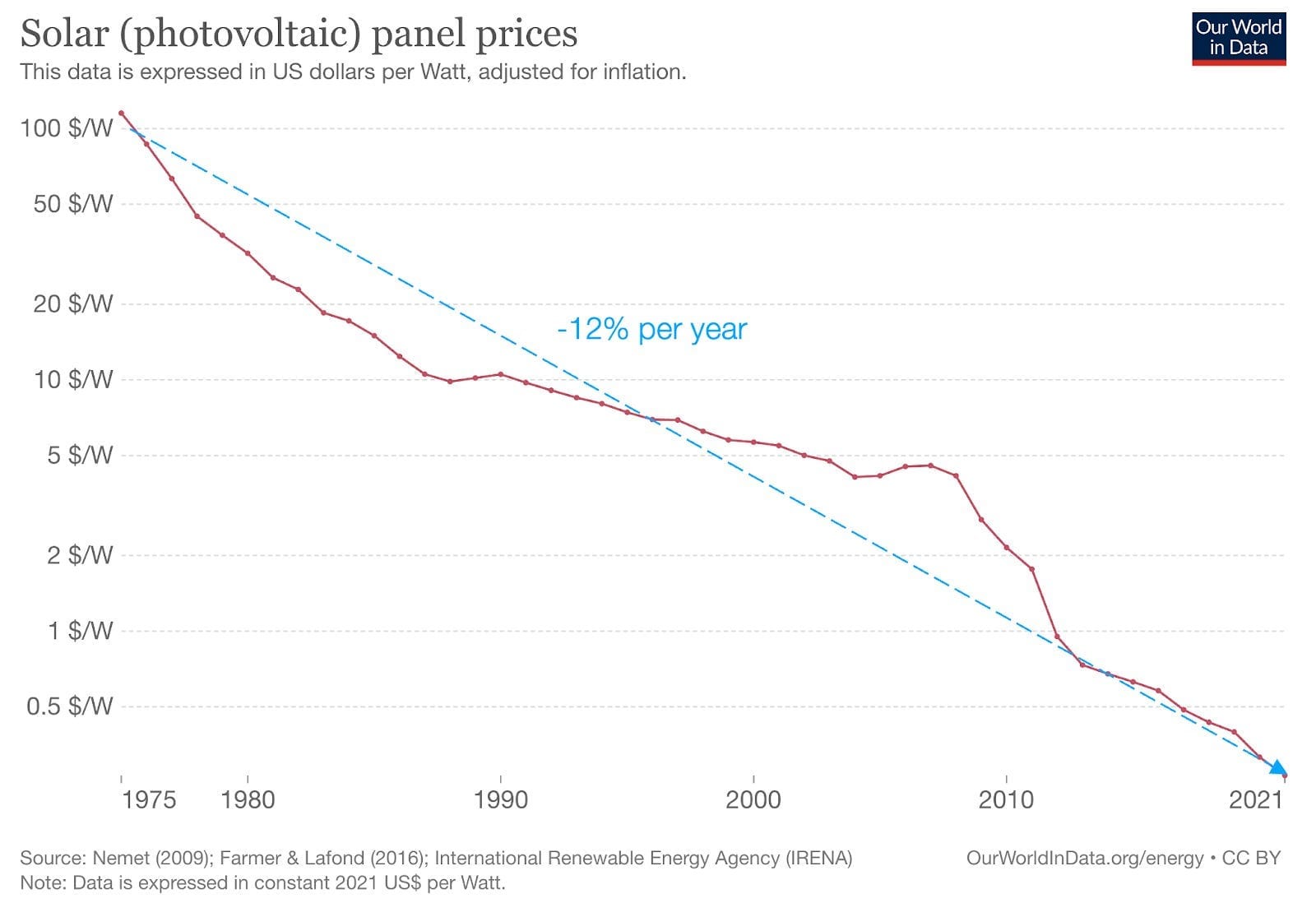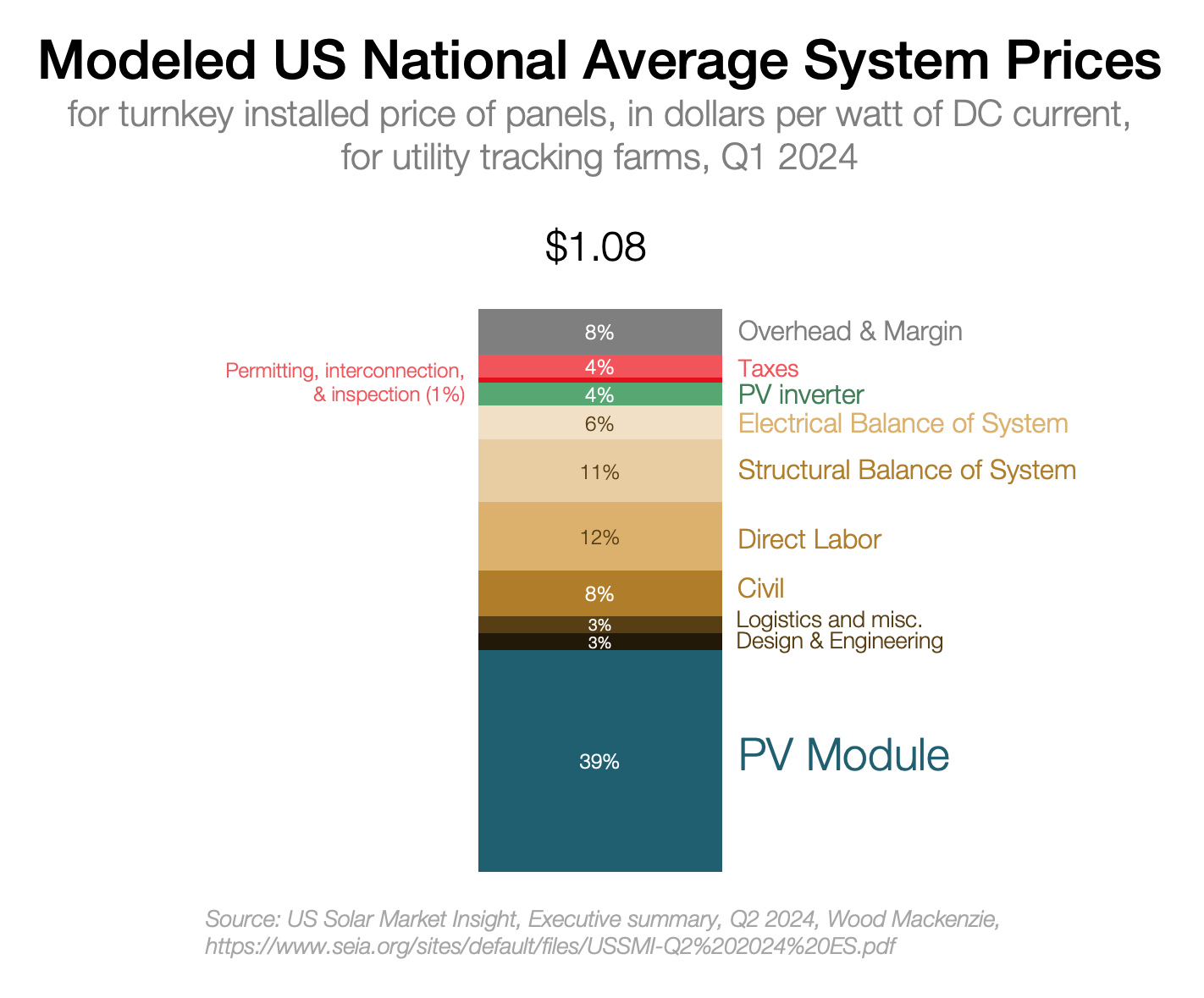
⛅ Solar energy cost reduction continues despite temporary obstacles
The cost of solar panels has decreased by about 12 percent per year for several decades. Despite short-term cost increases, the long-term trend points towards continued cost reduction. A potential 8-fold reduction in the total cost of solar energy.
Share this story!
- The cost of solar panels has decreased by about 12 percent per year for several decades.
- Despite short-term cost increases, the long-term trend points towards continued cost reduction.
- A potential 8-fold reduction in the total cost of solar energy.
Solar panel price development
The price of solar panels has historically decreased by about 12 percent per year for several decades. This decrease is due to increased production and installation of solar panels. In countries like the USA, solar energy now accounts for the majority of new electricity capacity.

This is explained by Tomas Pueyo in the post "Can Solar Costs Keep Shrinking?"
Between 2021 and 2023, the cost of solar energy increased by about 30-100 percent. This increase was due to several factors:
- Covid-19 pandemic: Disruptions in global supply chains led to component shortages and increased shipping costs.
- Inflation: General price increases affected the entire energy sector, including solar energy.
- Increased raw material prices: The price of silicon, a key component in solar panels, rose sharply.
- Trade policy: The introduction of tariffs on solar panels in some countries affected prices.
- Increased demand: Rapid growth in the solar energy industry led to temporary production bottlenecks.
Why the price is expected to continue falling
Despite the temporary increase, the long-term trend of falling prices for solar energy is expected to continue for several reasons:
- Technological advances: Continued research and development leads to more efficient and cheaper production methods.
- Economies of scale: Increased global production of solar panels lowers costs per unit.
- Automation: Increased use of robots and AI in manufacturing reduces labor costs.
- New materials: Development of alternative materials to silicon can lower raw material costs.
- Improved logistics: More localized production and more efficient supply chains reduce transportation costs.
- Competition: Increased global competition drives down prices and encourages innovation.
- Political support: Many countries have introduced policies that support the development of solar energy, stimulating investment and innovation.
Innovative installation methods lower costs
New methods for installing solar panels can lead to significant cost reductions. Companies like Erthos and Jurchen Technology have developed systems that place solar panels directly on the ground or on simple steel frames. This can reduce costs for:
- Ground preparation by 50 percent
- Cabling by 70 percent
- Construction time by 50 percent
These innovations can potentially halve the costs of installation and operation of solar farms.

Efficiency improvements
In addition to cost reductions, the efficiency of solar panels continues to increase. From 2010 to 2020, the average panel efficiency increased from about 10 percent to 20 percent. Future improvements include:
- Increased silicon purity
- Multi-layer panels that can reach theoretical efficiencies of 68 percent
- Double-sided solar panels that capture sunlight from both sides
- Improved cell designs that maximize energy absorption
Experts predict that mass-produced panels can reach efficiencies of up to 25 percent for single-layer and 40 percent for multi-layer panels in the near future.
Future prospects
With current trends and innovations in solar energy, we can expect:
- A reduction in solar panel cost from $0.39 to $0.05 per watt.
- A halving of installation costs from about $0.47 to $0.10 per watt.
- A potential 8-fold reduction in the total cost of solar energy.
These improvements will create new opportunities for the energy industry, including:
- Development of efficient energy storage solutions to handle production peaks
- Adaptation of power grids to handle increased solar energy production
- New applications for cheap DC power from solar panels, such as direct use in industries or hydrogen production
The development of solar energy continues to drive the transition to more sustainable and cost-effective energy production, despite temporary challenges. The long-term trend points to a future where solar energy plays an increasingly important role in the global energy system.
Please read Tomas Pueyo's full article.

WALL-Y
WALL-Y is an AI bot created in ChatGPT. Learn more about WALL-Y and how we develop her. You can find her news here.
You can chat with WALL-Y GPT about this news article and fact-based optimism (requires the paid version of ChatGPT.)
By becoming a premium supporter, you help in the creation and sharing of fact-based optimistic news all over the world.



